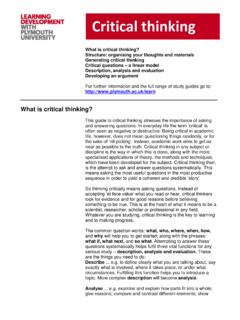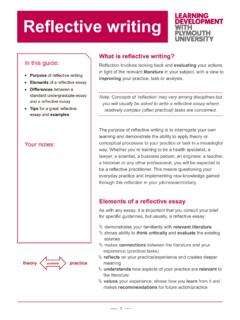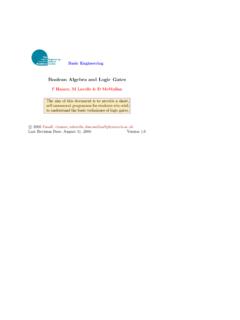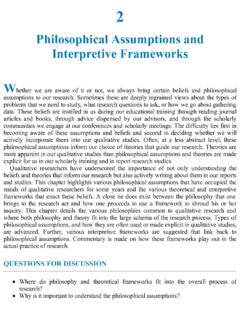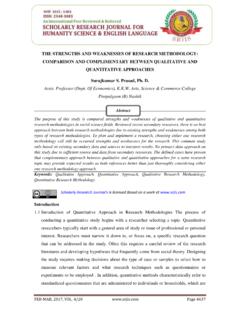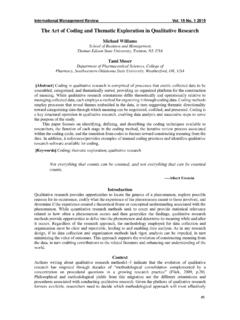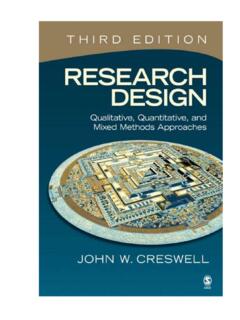Transcription of Thematic analysis of qualitative data: AMEE Guide No. 131
1 Full Terms & Conditions of access and use can be found TeacherISSN: 0142-159X (Print) 1466-187X (Online) Journal homepage: analysis of qualitative data: AMEE GuideNo. 131 Michelle E. Kiger & Lara VarpioTo cite this article: Michelle E. Kiger & Lara Varpio (2020): Thematic analysis of qualitative data: AMEE Guide No. 131, Medical Teacher, DOI: link to this article: online: 01 May your article to this journal Article views: 2167 View related articles View Crossmark dataAMEE GUIDET hematic analysis of qualitative data: AMEE Guide No. 131 Michelle E. Kigera,band Lara Varpioa,baWright-Patterson Medical Center, Dayton, OH, USA;bUniformed Services University of the Healthy Sciences, Bethesda, MD, USAABSTRACTT hematic analysis is a widely used, yet often misunderstood, method of qualitative data analysis . Itis a useful and accessible tool for qualitative researchers, but confusion regarding the method sphilosophical underpinnings and imprecision in how it has been described have complicated itsuse and acceptance among researchers.
2 In this Guide , we outline what Thematic analysis is, posi-tioning it in relation to other methods of qualitative analysis , and describe when it is appropriateto use the method under a variety of epistemological frameworks. We also provide a detailed def-inition of atheme, as this term is often misapplied. Next, we describe the most commonly usedsix-step framework for conducting Thematic analysis , illustrating each step using examples fromour own research . Finally, we discuss advantages and disadvantages of this method and alertresearchers to pitfalls to avoid when using Thematic analysis . We aim to highlight Thematic analysisas a powerful and flexible method of qualitative analysis and to empower researchers at all levelsof experience to conduct Thematic analysis in rigorous and thoughtful analysis ; qualitative researchmethods; qualita-tive analysisIntroductionData analysis has been described as the most complex andmysterious of all of the phases of a qualitative project, andthe one that receives the least thoughtful discussion in theliterature (Thorne2000).
3 Many qualitative research paperslack explicit description of the methods informing dataanalysis, or, when included, the terms used to describedata analytic methods are often used imprecisely or aremislabeled entirely (Sandelowski and Barroso2003;Sandelowski2010). Further complicating matters, certainterms describing qualitative data analysis have either car-ried a wide range of definitions or lacked clear imprecision leads to a lack of transparency, making itdifficult for readers to understand how data analysis wasperformed and, consequently, how to interpret findings(Nowell et ). It also contributes to perceptions thatqualitative research is less rigorous than quantitativeresearch (Clarke and Braun2013).Unfortunately, this lack of clear terminology plagues aqualitative data analysis method that is among those mostfrequently used in health professions education (HPE) research : Thematic analysis .
4 Thematic analysisis a term thathas been variably defined (Merton1975; Aronson1995;Boyatzis1998; Attride-Stirling2001; Braun and Clarke2006;Joffe2011), and that has even been discounted asunsophisticated or inferior to other qualitative methods(Braun and Clarke2006,2014). Many researchers who usethematic analysis fail to provide sufficient descriptions ofthe analysis process followed and of the theories or epis-temological assumptions undergirding the analyses(Attride-Stirling2001; Braun and Clarke2006). Additionally,many studies that have employed Thematic analysis havenot explicitly labeled it as such in their manuscripts;instead, these reports simply state that qualitative datawere examined for recurring themes , without offeringfurther explanation (Braun and Clarke2006). Clearly there isconsiderable confusion amongst researchers aboutwhat Thematic analysis means, when to use it, and how touse analysis is a practical data analysis approachfor qualitative researchers; clarifying how to use itPractice points Thematic analysis is a powerful yet flexiblemethod for analyzing qualitative data that can beused within a variety of paradigmatic or epis-temological orientations.
5 Thematic analysis is an appropriate method ofanalysis for seeking to understand experiences,thoughts, or behaviors across a data set. Themes are actively constructed patterns (ormeanings) derived from a data set that answer aresearch question, as opposed to mere summariesor categorizations of codes. Themes can be gen-erated inductively or deductively. The most widely-accepted framework for conduct-ing Thematic analysis involves a six-step process:familiarizing yourself with the data, generating ini-tial codes, searching for themes, reviewingthemes, defining and naming themes, and pro-ducing the report. Given the flexibility of Thematic analysis , research -ers using this method must clearly outline theirparadigmatic orientations and assumptions toensure the trustworthiness of their findings E. Medical Center, 4881 Sugar Maple Dr, Dayton, OH 45433, USA 2020 AMEEMEDICAL and effectively can help HPE researchers rec-ognize its utility, versatility, and power.
6 In this Guide , weaim to support the achievement of these goals. First, wedefine Thematic analysis , focusing on the flexibility that itoffers researchers. We explore how it can be applied acrossa range of theoretical and epistemological frameworks. Wealso suggest when Thematic analysis can be harnessed inqualitative data analysis . Next, we focus on some key con-cepts underpinning Thematic analysis . Specifically, we dis-cuss the definition of a theme, including different types ofthemes ( semantic versus latent), and how inductive ordeductive processes can be employed to develop then describe a stepwise approach for conducting the-matic analysis , following the six-step framework of Braunand Clarke (2006) and providing a worked example fromour own research data to illustrate each step. We concludewith a discussion of the advantages and disadvantages ofusing Thematic analysis , and a description of pitfallsto is Thematic analysis ?
7 Thematic analysis is a method for analyzing qualitativedata that entails searching across a data set to identify,analyze, and report repeated patterns (Braun and Clarke2006). It is a method for describing data, but it alsoinvolves interpretation in the processes of selecting codesand constructing themes. A distinguishing feature of the-matic analysis is its flexibility to be used within a widerange of theoretical and epistemological frameworks, andto be applied to a wide range of study questions, designs,and sample sizes. While some scholars have described the-matic analysis as falling within the realm of ethnography(Aronson1995) or as particularly suited to phenomenology(Joffe2011), Braun and Clarke (2006) argue that thematicanalysis can stand alone as an analytic methodandbeseen as foundational for other qualitative research meth-ods. Indeed, the principles of Thematic analysis of how tocode data, to search for and refine themes, and to reportfindings are applicable to several other qualitative methodssuch as grounded theory (Watling and Lingard2012) anddiscourse analysis (Taylor et ).
8 Because of this flexi-bility, Braun and Clarke (2006) refer to Thematic analysis asa method, as opposed to a more tightly analysis is not bound to a particular paradig-matic orientation ; instead, it can be used within post-posi-tivist, constructivist, or critical realist research approaches(Braun and Clarke2006). Using Thematic analysis in differ-ent research paradigms entails harnessing this method todistinct purposes and outputs. Post-positivists can use the-matic analysis to focus on individuals meanings and expe-riences to gain insights into the external reality, therebysupporting the development of conjectural knowledgeabout reality. In many interpretivist orientations ( con-structivism), Thematic analysis can emphasize the social,cultural, and structural contexts that influence individualexperiences, enabling the development of knowledge thatis constructed through interactions between the researcherand the research participants, revealing the meanings thatare socially constructed (Braun and Clarke2006).
9 Joffe(2011) suggests that Thematic analysis is particularly suitedto constructivism because, through the process of analyz-ing a wide range of data, it can illustrate how a certainsocial construct develops. In these ways, constructivist the-matic analyses will search for more latent, deeper themeswithin the data. Finally, critical realism acknowledges expe-riences and perceptions grounded in a material reality butseeks to investigate social meanings and implicationsbehind the topic of interest (Joffe2011; Clarke and Braun2017). Within a critical realist framework, Thematic analysiscan allow researchers to study the power relations inform-ing reality and to engage in emancipatory investigationsthat value the voices of oppressed those who have described Thematic analysis as apost-positivist method (Aronson1995; Boyatzis1998).Boyatzis (1998) forwards Thematic analysis as a methodthat can bridge the chasm between the post-positivist pur-suit of understanding a reliable, objective, fact-based real-ity, and the more interpretive aims of many social scienceresearchers.
10 Boyatzis posits that Thematic analysis allowsthe interpretive social scientist s social construction ofmeaning to be articulated or packaged in such a way, withreliability as consistency of judgment, that description ofsocial facts or observations seems to emerge (p. xiii). Hesuggests that the interplay between post-positivist andinterpretivist paradigms within Thematic analysis can pro-duce a symbiosis in which interpretive findings can gener-ate new hypotheses to be tested using post-positivistmethods, and post-positivist hypothesis testing can in turnsuggest new themes for exploration from an interpret-ive to use Thematic analysisThanks in large part to those who have clearly laid out itsanalytical processes (Braun and Clarke,2006,2012; Clarkeand Braun2017), researchers have suggested that thematicanalysis is a good first analytic method for novice qualita-tive researchers to master (Braun and Clarke2006,2012;Clarke and Braun2017; Nowell et ).


